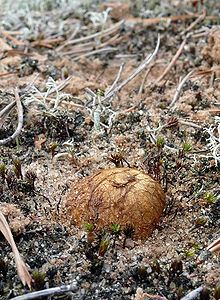
A truffle is the fruiting body of a subterranean ascomycete fungus, predominantly one of the many species of the genus Tuber. In addition to Tuber, many other genera of fungi are classified as truffles including Geopora, Peziza, Choiromyces, Leucangium, and over a hundred others. These genera belong to the class Pezizomycetes and the Pezizales order. Several truffle-like basidiomycetes are excluded from Pezizales, including Rhizopogon and Glomus. Truffles are ectomycorrhizal fungi, so are usually found in close association with tree roots. Spore dispersal is accomplished through fungivores, animals that eat fungi. These fungi have significant ecological roles in nutrient cycling and drought tolerance.
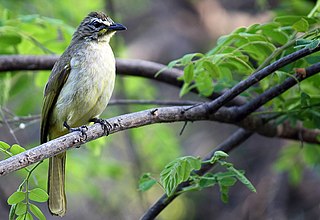
The white-browed bulbul is a member of the bulbul family of passerine birds. It is a resident breeder in Sri Lanka and peninsular India. Largely olive coloured above with whitish underparts, it has a pale supercilium and a yellow vent. They are found in dense scrub habitats, where they skulk within vegetation and can be difficult to see although their loud and distinct burst of calls is distinctive.
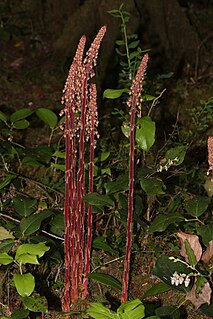
Pterospora, commonly known as pinedrops, woodland pinedrops, Albany beechdrops, or giant bird's nest is a North American genus in the subfamily Monotropoideae of the heath family, and includes only the species Pterospora andromedea. It grows in coniferous or mixed forests. It is widespread across much of Canada as well as the western and northeastern United States to and northern Mexico. Along with Monotropa it is one of the more frequently encountered genera of the Monotropoideae.

Rhizopogon roseolus is an ectomycorrhizal fungus used as a soil inoculant in agriculture and horticulture. It is considered a delicacy in east Asia and Japan where it is traditionally known as shoro. Techniques for the commercial cultivation of this fungus in pine plantations have been developed and applied with successful results in Japan and New Zealand.
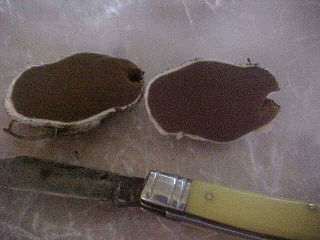
Rhizopogon subcaerulescens is an ectomycorrhizal fungus used as a soil inoculant in agriculture and horticulture. The species was described by American mycologist Alexander H. Smith in a 1966 publication.

Rhizopogon villosulus is an ectomycorrhizal fungus used as a soil inoculant in agriculture and horticulture. It was first described scientifically by mycologist Sanford Myron Zeller in 1941.
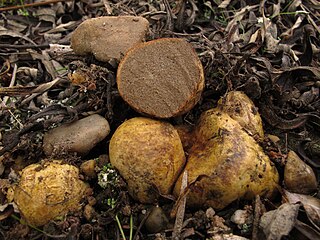
Rhizopogon vulgaris is an ectomycorrhizal fungus used as a soil inoculant in agriculture and horticulture.

Rhizopogon is a genus of ectomycorrhizal Basidiomycetes in the family Rhizopogonaceae. Species form hypogeous sporocarps commonly referred to as "false truffles". The general morphological characters of Rhizopogon sporocarps are a simplex or duplex peridium surrounding a loculate gleba that lacks a columnella. Basidiospores are produced upon basidia that are borne within the fungal hymenium that coats the interior surface of gleba locules. The peridium is often adorned with thick mycelial cords, also known as rhizomorphs, that attach the sporocarp to the surrounding substrate. The scientific name Rhizopogon is Greek for 'root' (Rhiz-) 'beard' (-pogon) and this name was given in reference to the rhizomorphs found on sporocarps of many species.

Raorchestes luteolus is a species of frog in the family Rhacophoridae. It is endemic to the Western Ghats, India, where it is only known from the state of Karnataka. Many of the known populations are from the Kodagu district, known also by its anglicised former name of Coorg—hence the common name. It is also known from the Shimoga district in the Sharavathi basin where it was described as a new species, Philautus neelanethrus, but this is now considered to be a junior synonym of Raorchestes luteolus.

The little weaver is a species of bird in the family Ploceidae. It is found in western, central and eastern Africa.

A false truffle or a hymenogastrale is any species of fungus that has underground fruiting bodies that produce basidiocarps resembling the true truffles of genus Tuber. While rodents such as squirrels eat a wide variety of false truffle species, many are considered toxic or otherwise inedible by humans and only a few are sought after as food.
Agromyces is a genus in the phylum Actinobacteria (Bacteria).
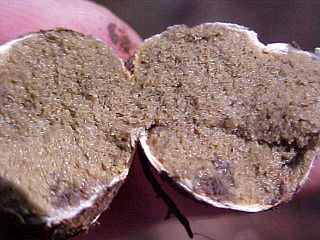
Rhizopogon vinicolor is a species complex of ectomycorrhizal fungus which forms a mutualistic relationship with the Douglas-fir. The species was first described scientifically by American mycologist Alexander H. Smith in 1966.
Rhizopogon alexsmithii is an ectomycorrhizal fungus in the order Boletales. Named in honor of American mycologist Alexander H. Smith, it was described as new to science in 1975 by James Trappe. Alfredo Vizzini and Mirca Zotti transferred it to the genus Rhizopogon in 2010.
Pontixanthobacter luteolus is a Gram-negative, halophilic and non-spore-forming bacterium from the genus Pontixanthobacter which has been isolated from tidal flat from the Yellow Sea in Korea.
Agromyces luteolus is a bacterium from the genus of Agromyces which has been isolated from the rhizosphere and soil from the tree Sonneratia alba from Okinawa in Japan.
Tumebacillus ginsengisoli is a species of Gram positive, aerobic, bacterium. The cells are rod-shaped, non-motile, and form spores. It was first isolated from soil in a ginseng field in Pocheon, South Korea, and the species name is derived from the ginseng soil isolation location. T. ginsengisoli was the second species added to the genus Tumebacillus.
Tumebacillus luteolus is a species of Gram positive, aerobic, bacterium. The cells are rod-shaped, non-motile, and form spores. It was first isolated from soil in Ukraine. The species was first described in 2015, and the name is derived from Latin luteolus (yellowish), referring to the colony color on R2A agar.

Rhizopogon salebrosus is a mushroom species within the Rhizopogon sub-genus Amylopogon. R.salebrosus is a monotropoid mycorrhiza that is of vital importance to the ecology of conifer forests, especially in the Pacific Northwest region of North America. Although it is native to North America, R. salebrosus has been found in Europe and its range is generally limited to mountainous regions with sufficient precipitation. The mycoheterotrophic plant, Pterospora andromedea is often found in an obligate association with R. salebrosus in western parts of the U.S. Eastern populations of P. andromedea are typically symbiotic with another Rhizopogon sub species, R. kretzerae.
